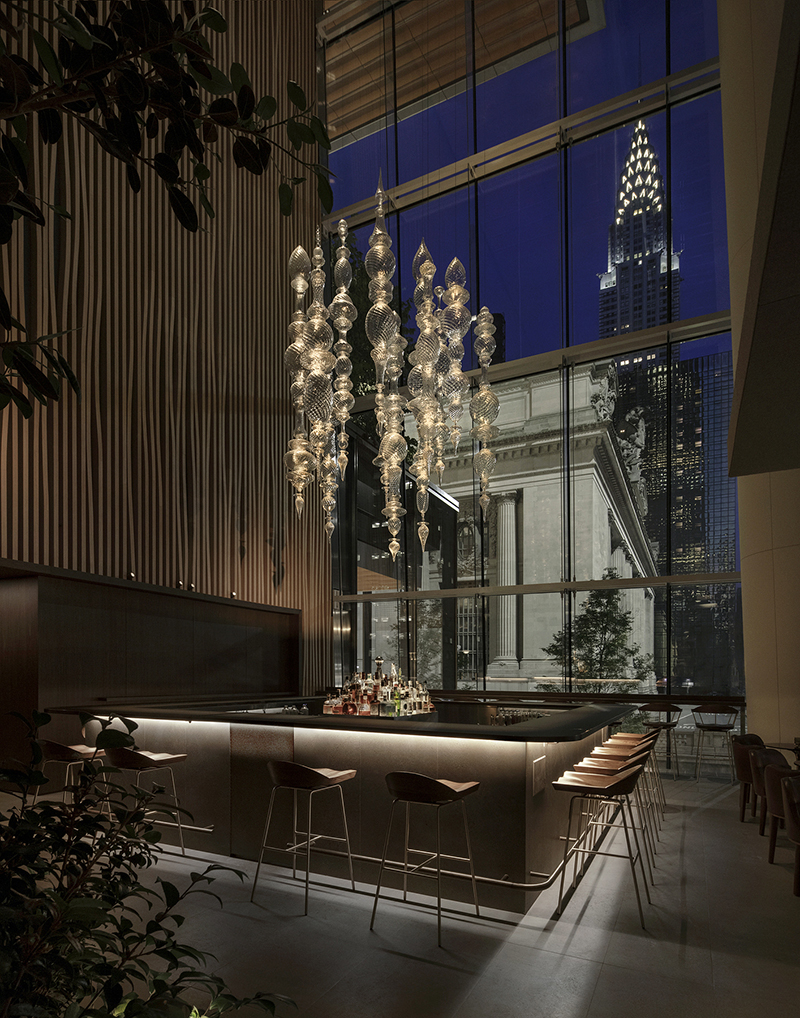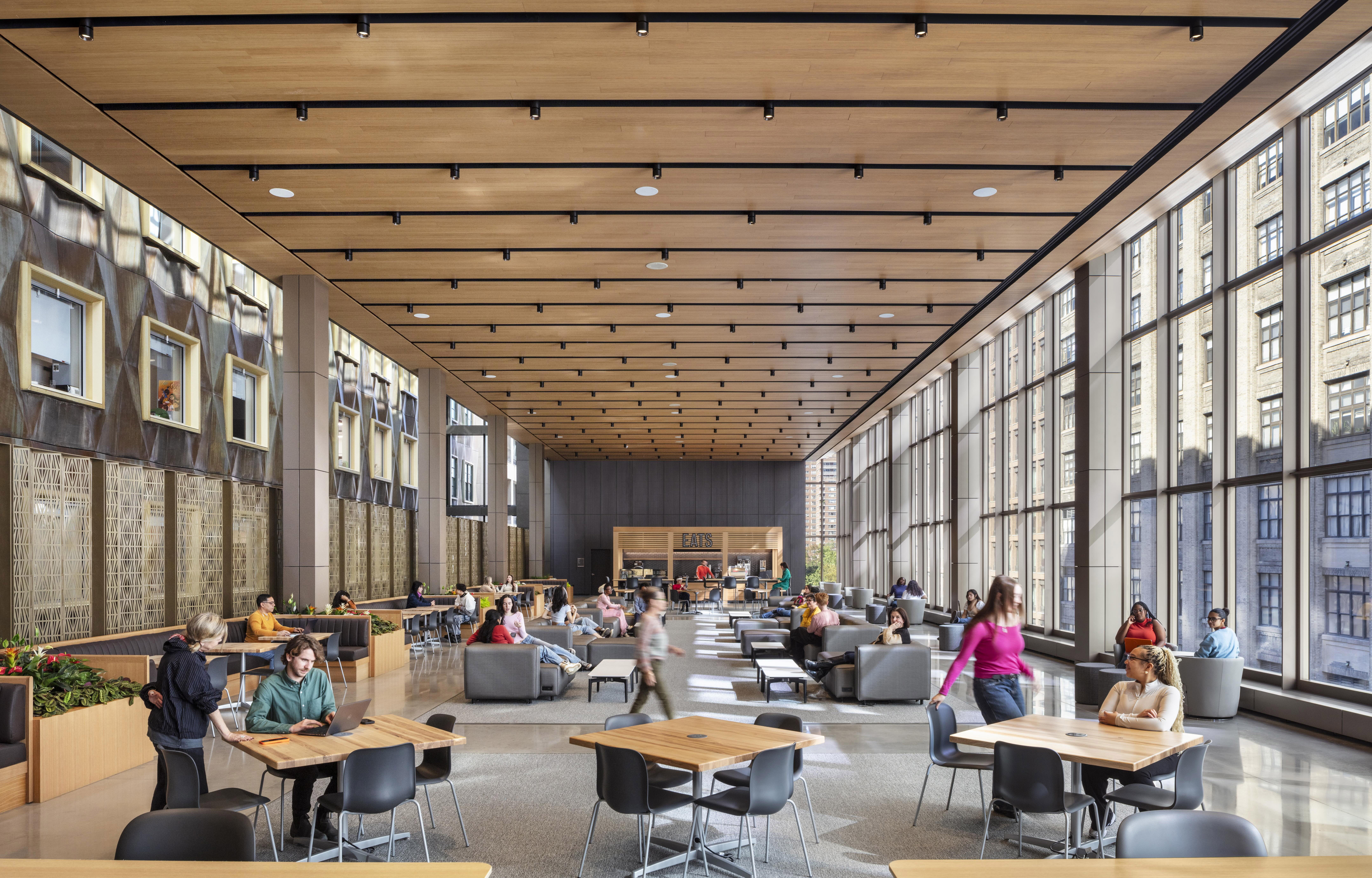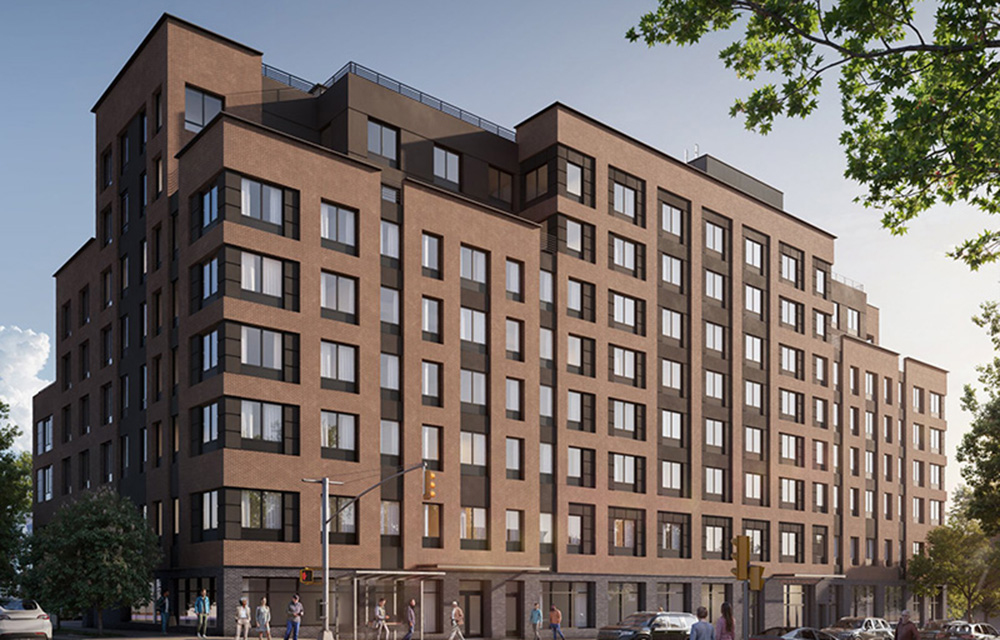Weinfeld, MDA and Shawmut Construction complete 11,000 s/f restaurant

Manhattan, NY The architectural team of Brazil-based architect Isay Weinfeld and New York City executive architect Montroy DeMarco Architecture (MDA), along with construction manager Shawmut Design & Construction, has completed Le Pavillon restaurant at One Vanderbilt.
Developed and operating under the guidance of Michelin-starred chef Daniel Boulud, the restaurant has won Engineering News-Record New York (ENR NY) magazine’s Best of the Year Award in the residential/hospitality category. The project was also a runner-up in the overall ENR NY best of the year competition due to its creative design and numerous technical innovations.
Le Pavillon is both a culinary and visual feast for guests. Located inside midtown Manhattan’s tallest tower, the 11,000 s/f dining space has views of Grand Central Station and the Chrysler Building. SL Green Realty developed and owns the 93-story, 1,401-ft. tall One Vanderbilt building.
SL Green partnered with the Dinex Group, founded by chef Boulud, on the creation of Le Pavillon. Chef Boulud was inspired by traditional French pavilions, used for celebrations and gatherings that are typically located in parks or on avenues lined with gardens and trees. “Our goal was to evoke a bygone era of French classic restaurants by allowing guests in the new millennium to savor fine cuisine prepared with fresh, healthy, and locally sourced ingredients within a garden retreat,” said Boulud.
“The design challenge was to create an intimate dining experience surrounded by nature within a towering 55-foot-high space, surrounded by a glass curtain wall, inside the newly completed 93-story One Vanderbilt, located on the corner of Vanderbilt Ave. and 42nd St.,” said MDA’s principal Steven Andersen.
Isay Weinfeld, known for incorporating green landscapes into his interior projects, was a natural choice to lead the design effort. “I believe we succeeded in making Le Pavillon warm and cozy within the impressive scale of the venue. The solution came with bringing in lush greenery, which makes for a soothing and peaceful ambience, to create an oasis amidst the hustle-bustle of the city,” said Weinfeld.
The collaboration between the designers was made easier due to their previous work on other New York City projects. Andersen said, “We had developed a strong relationship with Isay Weinfeld during our recent collaborations on Manhattan’s Four Seasons restaurant and a high-end residential project. He understood the desire to capture the spirit of a New York skyscraper living in harmony with nature perfectly.”
Other project team members included M/E/P engineer JB&B; lighting designer Dot Dash; landscape architect Future Green Studio; structural engineer Severud; acoustic consultant Cerami; AV consultant TAD; and food service consultant Next Step Design.
Design, Layout, and Materials
Le Pavillon is located on the second floor of One Vanderbilt, visible to pedestrians from the street below. A street level entry vestibule has a dedicated stair and elevator that lead to the dining room and kitchen above. The dining room layout accommodates up to 120 seated guests. A semi-private Garden Table is reserved for special food and wine experiences, and a 46-seat bar and lounge overlook the new Vanderbilt Plaza. Christopher White, MDA project architect said, “the geometry of the space did not initially provide the cozy atmosphere desired by the clients. MDA worked with Weinfeld to develop the design of a sloped, soffited ceiling, supported from existing building beams at the curtain wall by cantilevered steel needle beams up to 26-ft. long, to cover half of the dining area. This visual reduction in height provided intimacy to the space. The height of the low ceiling varies from 7’-6” to 14”.”
Mechanical systems, including ventilation, lighting, fire sprinklers, sound, and security cameras are concealed within the ceiling, and were coordinated to keep the ceiling as thin as possible. The ceiling membrane is constructed of perforated acoustic drywall with an acoustic fabric overlay to control noise and echo in the large space. It is wrapped in a stretch acoustic fabric by Gilford of Maine. The finish fabric hides the sound system speakers from view but permits sound transmission from speakers above it
The remaining area of the dining room beyond the low ceiling has a full ceiling height of 55 ft. This area is filled with greenery, selected to act as a backdrop for the interior landscape. The use of custom materials is apparent from the initial street level entry. Italian Breccia di Versailles Levigato marble wrap the structural steel stair and landings, while Venetian plaster line walls throughout the entry and the dining space.
The exterior walls of the space are full height glass curtain wall providing views of the surrounding cityscape. In contrast, the interior wall spanning the full length and height of the space is clad with thin undulating vertical slats of rift european white oak that visually connect with the organic forms of the surrounding plantings. Bretagna brown stone, also imported from Italy, covers 3,400 s/f of the dining room floor and clads the main bar. A custom acid-etched matte glass top with embedded purple and yellow color gradients, created by Dutch artist Sabine Marcelis, accents the bar. A second bar adjacent to the kitchen entrance hallway is faced with custom bronze and stainless steel inserts.
The use of custom materials sources overseas extends into the restrooms, with Moroccan Zellige terracotta wall tiles, Italian Bianca Venezia stone floors and countertops, and Dutch Maharam wallcoverings in the corridor.
The project also includes an 8,000 s/f chef-centered kitchen with an elevated office that allows chef Boulud an encompassing view of the food preparation area. The custom range suites and a full service bakery area with a pastry oven were designed and manufactured by the French company Athenor.
The 900 s/f lower level of the space houses a less formal Épicerie Boulud. This eat-in/take-out market offers chef’s freshly baked breads, pastries and viennoiserie, alongside home-made soups, salads, and sandwiches.
Creating the Planting Areas
One of the project’s main challenges was the integration of a 775 s/f planting area, supported by 2,000 s/f of dedicated infrastructure, that would be at the same finished elevation as the dining room floor.
“The planting area sits directly above the MTA Transit Hall entrance to Grand Central Station, where escalators lead down to the concourse level,” said David Margolius, executive vice president of Shawmut Design and Construction’s New York Metro region. “In order to accommodate the soil depth requirements of the various plants without affecting the structural framing, the team created three-foot-deep planter pits in between beams.”
The team drilled the concrete slabs using a demolition robot to create the pit depressions, and then waterproofed the pits and the sections above the intersecting beams with a double-layer cold-applied Kemper exterior-grade roofing system. A passive drainage system, similar to those used on green roofs, was then installed above the waterproofing by layering a matrix of multiple protection courses and drainage mats integrated with French drains running adjacent to the structural members. All of the drains pitched toward the feature wall and water is removed from that central point. The remaining depth of the pits was completely filled with soil, including a 6” deep layer above the beams.
A fully automated “fertigation” system, combining both water and fertilizer, maintains the moisture and nutrient level in the planting bed. The system is carefully calibrated, with drip components and meters that slowly release water, to minimize overwatering. Blondie’s Treehouse installed the irrigation system and is responsible for ongoing plant and system maintenance. A topping of shredded moss mulch in the planting beds emulates the appearance of a woodland surface.
Once the base beds were installed, CMU knee walls were built within the pits to support the concrete slabs on deck that created the pathways and seating sections within the planting area. Custom banquette seating is nestled along the meandering edges of the plant beds to integrate the restaurant seating and tables with the landscape and to provide a semi-private dining experience for the guests.
Landscape Concept and Plant Materials
The landscape design is evocative of a New York woodland, and plants were chosen both for their indoor durability and their aesthetic resemblance to native species. The interior garden utilizes a lighting system integrated with the architecture to achieve adequate light levels to support all the plants.
Future Green developed a base palette of 20 species that would both thrive in a controlled indoor environment and evoke a lush temperate forest landscape. “Plant selection was a considered process. It balanced the horticultural and design requirements to create a garden that would thrive and enchant,” said Nancy Seaton, sr. associate + horticulturist with Future Green Studio.
A total of about 1,000 plants were installed. Plantings are divided into five layers. The tallest are a canopy of Black Olive ‘Shady Lady’ (Bucida buceras) trees. Below them is a shrub layer to create privacy around the dining areas, including the conifer Plum Yew (Podocarpus macrophyllus) and Umbrella Plant (Schefflera arboricola). Accent perennials, including a variety of ferns, and seasonal plants provide changing color and punctuate the ground with contrasting foliage. Ground covers such as Strawberry Begonia (Saxifraga stolonifera) and Parallel Perpermia (Peperomia puteolata) conceal the soil and create a carpet of green. Finally, Wire Vine (Muehlenbeckia axillaris) will cascade over the entry stair railings within a short time, along with star jasmine, grape ivy, and creeping fig. The plants in the understory are the ZZ Plant (Zamioculcas zamiifolia) and Cast Iron Plant (Aspidistra elatior).
Lighting Design and the Custom Chandelier
“Lighting is an integral component of landscape design. Its function is to both highlight the design and provide grow lighting for the plants,” said Christopher Cheap, president of Dot Dash. “Two levels of grow lighting were required – above the 20-foot high tree canopy and at the undergrowth level of lower plants. Separate light levels were developed to accommodate each.”
At the canopy level, full spectrum high intensity LED lights by Light Lab provide 250-300 ft. candles for the trees. The fixtures, which are only 2.5-inches in diameter, are fully recessed into the high terracotta ceiling panels and the light is diffused by the time it reaches floor level. The lights are calibrated over the course of each week to generate an ideal overall cumulative light level, with a sliding schedule that provides more light during the hours when the restaurant is closed. The cumulative light level is calculated based on the degree of natural light that permeates the space, which varies by the time of year and with shadows cast by adjacent buildings.
A second layer of warm white light is used at floor level. Custom post fixtures with polished knife edge caps designed by Dot Dash provide ambient light so that the source is not visible, but the plants and shrubs are illuminated. Accent lighting fixtures in the planter beds uplight the tree canopies and create sculptural illumination for the plants. All of the landscape lights were manufactured by B-K Lighting. The final lighting layer is provided by theatrical “gobo” fixtures by ETC, located on top of the soffit ceiling, that complete the woodland imagery by using metal screens to project shadowy foliage shapes onto the feature wall and five-foot diameter columns.
Lighting is carefully controlled to enhance the perception of daylight within the space. Small one-half-inch-diameter pin lights are scattered across the ceiling of the main dining room, alluding to stars in the night sky. The fixture pattern was carefully developed to provide a uniform light level throughout the dining room to support flexibility in the table configurations and locations.
A focal point in the lighting design is the custom chandelier suspended over the bar. Dot Dash worked with noted glass artist Andy Paiko to create this sculptural object. The full height contemporary style curtain wall surrounding the bar provides a view of the adjacent Beaux Arts style Grand Central Station and the Art Deco Chrysler Building.
Dot Dash and Paiko, in collaboration with Weinfeld, MDA, and SL Green, developed the technical requirements for the piece. A full-scale mockup was created and temporarily hung within the space enabling the team to refine the scale and stacking order of the individual components. The resultant 12-foot-tall chandelier consists of 264 pieces of glass in a variety of sizes and organic shapes, each hand formed and blown using a traditional Venetian Cristallo recipe that results in a super-clear, crystal-like glass with low lime content and no coloration from mineral impurities.
The glass globes, ranging in size from 12 to 18 in., and lighting components are hung on metal aircraft cables of varying lengths from the 55-foot-high ceiling, and the installation required careful planning. The Shawmut team dismantled the existing terra cotta ceiling system to install structural hang points to mount the cables. The installation was performed by ColeNYC, licensed NYC master riggers hired by Shawmut, due to the height and logistics of the work. These master riggers, who normally work on emergency stabilizations on building facades and are accustomed to working in high inaccessible areas, are fully SPRAT (Society of Professional Rope Access Technicians) certified and followed all industry guidelines for this project.
Construction Challenges
“Chef Daniel Boulud’s Le Pavillon is a testament to the strength and resiliency of New York City, and its opening at a crucial turning point during the pandemic was a signal of hope for all of us,” said David Margolius, executive vice president of Shawmut Design and Construction’s New York Metro region. “We were honored to have the opportunity to work again with Chef Boulud, SL Green, and all our project partners within One Vanderbilt, executing both highly-complex structural work and precisely-focused details to create a truly unparalleled restaurant.”
The project team faced a number of logistical challenges due to the COVID-19 pandemic and the project’s location in the heart of Midtown. These challenges included material and plant deliveries, long lead items, and COVID-19 protocols.
One challenge was the delivery of 12 large black olive trees that form a main focal point of the interior landscape. The trees, with a total weight of 10,000 lbs., were trucked to the site from a nursery in Florida. The only way to install the trees was to remove a portion of the glass façade to provide direct access into the space from the street.
The custom finishes included several long lead items that had to be ordered early in the project to maintain the completion schedule. Production and installation of the Bretagna stone for the floor and bar face in the dining room became a critical path activity. Shawmut’s team created 3D models using Building Information Modeling (BIM) to share the exact measurements with the supplier in Italy so that the pieces could be pre-cut to size prior to shipment. This process enabled the installation time to be shortened, and also minimized the impact of delays imposed on international shipping due to COVID-19.
In response to the pandemic, Shawmut developed a robust safety plan, created in partnership with trade unions, industry peer groups, and other leading firms, to minimize coronavirus exposure and risk across all jobsites once construction was permitted to resume. The plan included safety protocols, new job-site innovation, and an exhaustive COVID-19 risk assessment and response plan. Shawmut Vitals, a custom technology platform designed in-house, checks for COVID-19 symptoms and manages contact tracing. Shawmut implemented stringent guidelines for social distancing, PPE use, disinfection and hygiene protocols, and on-site communication and emergency procedures.
Troutbrook expands with boutique condo project and Marriott Fairfield Inn & Suites renovation








.gif)
.jpg)

.gif)